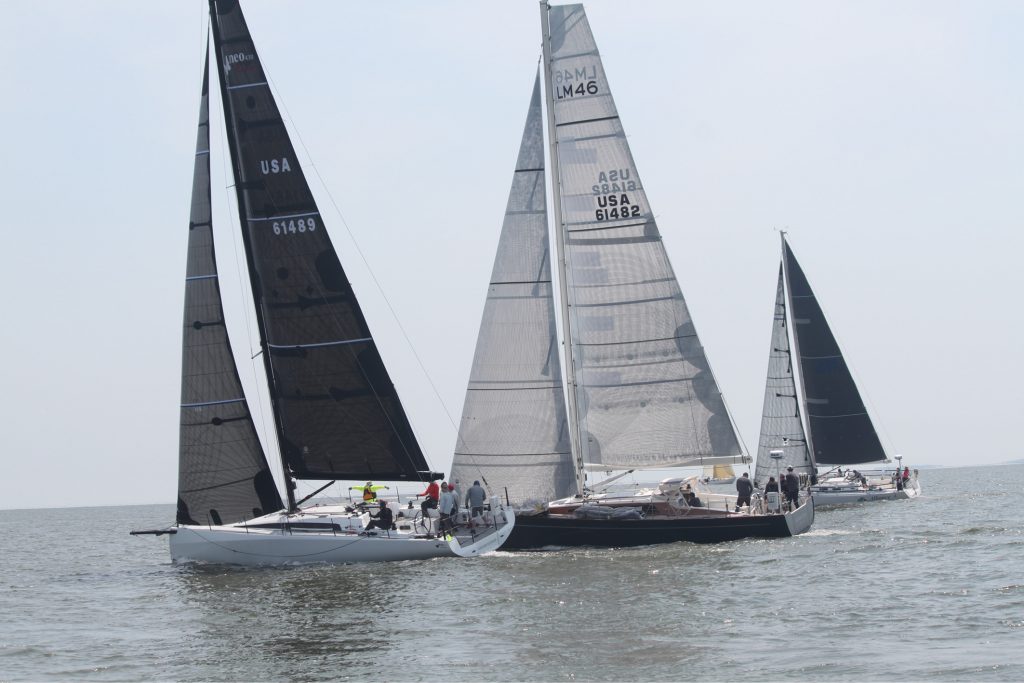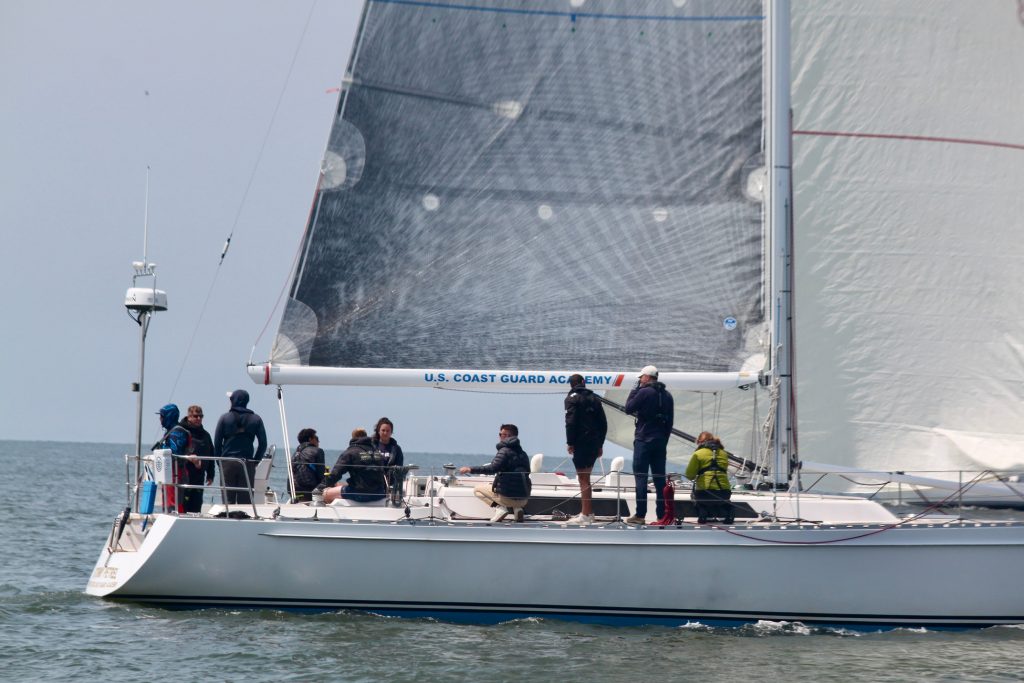By Phil Dickey, MD, Skipper, Flying Lady
Sam Wetherill, a founding member of the Cruising Club of America and early advocate of ocean racing, would have been pleased with the wind and sea conditions that prevailed during Essex Yacht Club’s 70th running of the race created to honor him. Two years ago, the race received a reconfiguration, which provides a longer (140nm) and more challenging open ocean race, which is especially suitable as a warmup to the Newport Bermuda Race. In particular, this year’s race was a microcosm of a typical Bermuda Race, featuring a light to moderate air start, dangerous squall conditions at night, no wind in the morning, and a light air finish, constantly dodging commercial traffic.
The race started at 11:40 am on Friday, May 20. An 8-knot easterly allowed the fleet to beat out of Long Island Sound, despite more than two knots of peak-flood currents. Except for two boats, the fleet tacked up the Connecticut shore to avoid the current; Trevor Fetter’s Black Watch, the classic 68-foot wooden Sparkman & Stephens yawl, and Eric Irwin and Mary Martin’s J/122 Alliance alternatively exited the Sound through Plum Gut.
Anticipating more pressure and a right shift to a southerly, most of the fleet sailed on port tack to round Block Island to port and then tight-reached out to the turning mark, the “G31” Bell, 1.65 nautical miles northwest of the Gay Head Light. However, several boats exited through Fishers Island Sound, led by Don Dwyer’s J/122 Blue Yonder (skippered by Tom Klin—Dwyer was quarantined at home with Covid) and Frank Flores’ new Neo 430 Rhumb Runner. Others exited the Sound through the Race but stayed north of Block, including Gretchen & Dan Biemesderfer’s Mason 43 Shearwater.

From left to right are Rhumb Runner, a Neo 430 skippered by Frank Flores, Hopgrasser, a Lyman-Morse 46 skippered by Drew Lyman, and Eric Irwin & Mary Martin’s J/122 Alliance. © Janet Philips
The boats who chose to leave Block Island to port were first to round G31: Black Watch at approximately 23:10, Arcadia (Eliot Merrill’s new Lyman-Morse 46, Hull #2) at 23:15, Alliance at 23:35, followed by Carina (Rives Potts’ two-time Bermuda Race-winning McCurdy & Rhodes Custom 48), Stormy Petrel (one of two U.S. Coast Guard Academy entries), and Froya (McCurdy & Rhodes Custom 46 skippered by Lane Tobin and Bill Gunther). These boats experienced on the way to G31 low-energy squalls with rain and gusty winds, which passed quickly.
The course back to Block Island (to be left to starboard on the return) began as a moderate close reach, but at approximately 02:00, squalls swept the fleet, this time with 35+ knot blasts (Shearwater’s Gretchen Biemesderfer estimates that they were hit with a 60-knot burst). Since the earlier squalls that affected the more southern boats had displayed relatively low wind speeds, most of those boats had continued with full mains and large headsails. The 02:00 winds wreaked havoc on sails—they completely tore the main on Blue Yonder and damaged genoas on Froya, Shearwater, Towhee (Paul Jennings’ Cal 40), and Hopgrasser (boat builder Drew Lyman’s Lyman-Morse 46, Hull #1). Sail damages forced Shearwater, Hopgrasser and Blue Yonder to retire. Froya considered retiring, but co-skipper Bill Gunther went up the mast to clear sails and halyards, continuing to race. Fortunately, there were no significant injuries despite substantial sail carnage.
As the fleet approached Block at around 06:00, a dense fog developed and the wind lightened, then disappeared. The boats that had been ahead gave up most of their leads as the remaining boats brought the diminishing breeze down with them. Essentially, a new race began southwest of Block, where the fleet wallowed in the leftover swell with either none or minimal breezes in an adverse current. Favorably, as the breeze slowly returned around 09:00 and the fog lifted a bit, the flood tide helped carry the boats back into the Sound for an afternoon finish at the Saybrook Outer Lighthouse. Line honors went to Arcadia.

Stormy Petrel, a Coast Guard Leadership 44 skippered by Officer Sam Stokes, U.S. Coast Guard Academy, took second in Class 1. © Janet Philips
On the following evening, the Essex Yacht Club hosted a fine prize-giving. Presenting the trophies, Vice Commodore and Race Chair Bill Gunther, who co-skippered Froya and climbed her rig in the storms, gave an eloquent special thanks to the USCGA crews. These cadets and officers not only took home silver but also represented the Academy well on the racecourse, at the prize-giving, and at the pre-race barbecue on May 19.
Full results are available on YachtScoring.com, but the winners in classes 1 (PHRF), 2 (ORC) and 3 (ORC), respectively, are: Flying Lady (Phil Dickey’s Swan 46), Carina, and Zig Zag (Andrew Clark’s J/122). The Race Committee, employing both EYC members (led by Mary Lawrence Bickford) and guests from the Mystic River Mudheads (led by Greg Gilmartin), provided clear and concise race documents and performed flawlessly at the start and finish.
The 2022 Sam Wetherill Trophy Overnight Race was a challenging ocean race, mimicking the conditions found in the Bermuda Race, only compressed into a little more than 24 hours. As pointed out by Rives Potts, the course provides a distinct variety of choices early in the race to balance wind and current, again much like the Bermuda Race. It provided an excellent preparatory experience, giving the skippers and crews a superb chance to evaluate their readiness. We anticipate an increasing number of competitors in future races as sailors seek adventure in the ocean.
To learn more about Essex Yacht Club’s upcoming races, log onto essexyc.com/On_The_Water/Racing. ■
Phil Dickey is a member of the Essex Yacht Club Regatta Committee.




